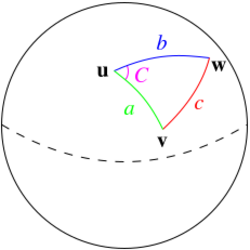Half-side formula
In spherical trigonometry, the half side formula relates the angles and lengths of the sides of spherical triangles, which are triangles drawn on the surface of a sphere and so have curved sides and do not obey the formulas for plane triangles.[1]
For a triangle [math]\displaystyle{ \triangle ABC }[/math] on a sphere, the half-side formula is[2] [math]\displaystyle{ \begin{align} \tan \tfrac12 a &= \sqrt{\frac{-\cos(S)\, \cos(S - A)} {\cos(S - B)\, \cos(S - C)} } \end{align} }[/math]
where a, b, c are the angular lengths (measure of central angle, arc lengths normalized to a sphere of unit radius) of the sides opposite angles A, B, C respectively, and [math]\displaystyle{ S = \tfrac12 (A+B+ C) }[/math] is half the sum of the angles. Two more formulas can be obtained for [math]\displaystyle{ b }[/math] and [math]\displaystyle{ c }[/math] by permuting the labels [math]\displaystyle{ A, B, C. }[/math]
The polar dual relationship for a spherical triangle is the half-angle formula,
[math]\displaystyle{ \begin{align} \tan \tfrac12 A &= \sqrt{\frac{\sin(s - b)\, \sin(s - c)} {\sin(s)\, \sin(s - a)} } \end{align} }[/math]
where semiperimeter [math]\displaystyle{ s = \tfrac12 (a + b + c) }[/math] is half the sum of the sides. Again, two more formulas can be obtained by permuting the labels [math]\displaystyle{ A, B, C. }[/math]
Half-tangent variant
The same relationships can be written as rational equations of half-tangents (tangents of half-angles). If [math]\displaystyle{ t_a = \tan \tfrac12 a, }[/math] [math]\displaystyle{ t_b = \tan \tfrac12 b, }[/math] [math]\displaystyle{ t_c = \tan \tfrac12 c, }[/math][math]\displaystyle{ t_A = \tan \tfrac12 A, }[/math] [math]\displaystyle{ t_B = \tan \tfrac12 B, }[/math] and [math]\displaystyle{ t_C = \tan \tfrac12 C, }[/math] then the half-side formula is equivalent to:
[math]\displaystyle{ \begin{align} t_a^2 &= \frac{\bigl(t_Bt_C + t_Ct_A + t_At_B - 1\bigr)\bigl({-t_Bt_C + t_Ct_A + t_At_B + 1}\bigr)} {\bigl(t_Bt_C - t_Ct_A + t_At_B + 1\bigr)\bigl(t_Bt_C + t_Ct_A - t_At_B + 1\bigr)}. \end{align} }[/math]
and the half-angle formula is equivalent to:
[math]\displaystyle{ \begin{align} t_A^2 &= \frac{\bigl(t_a - t_b + t_c + t_at_bt_c\bigr)\bigl(t_a + t_b - t_c + t_at_bt_c\bigr)} {\bigl(t_a + t_b + t_c - t_at_bt_c\bigr)\bigl({-t_a + t_b + t_c + t_at_bt_c}\bigr)}. \end{align} }[/math]
See also
- Spherical law of cosines
- Law of haversines
References
- ↑ Bronshtein, I. N.; Semendyayev, K. A.; Musiol, Gerhard; Mühlig, Heiner (2007), Handbook of Mathematics, Springer, p. 165, ISBN 9783540721222[1]
- ↑ Nelson, David (2008), The Penguin Dictionary of Mathematics (4th ed.), Penguin UK, p. 529, ISBN 9780141920870, https://books.google.com/books?id=ud3sEeVdTIwC&pg=PT529.
 |


